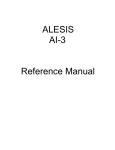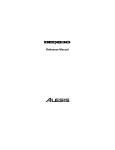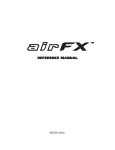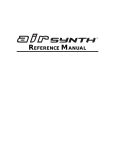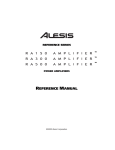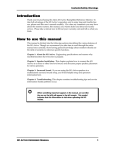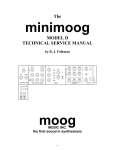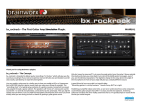Download Alesis CLX440 Specifications
Transcript
Five-Band Parametric Equalizer Reference Manual 2001 PEQ-450 Reference Manual 1 PEQ-450 Manual 2 PEQ-450 Reference Manual PEQ-450 Manual Contents Welcome!........................................................................................................................6 How to Use This Manual ...........................................................................7 Important Safety Instructions....................................................................8 Quick Start Guide .......................................................................................................15 If you can't wait to get started:................................................................15 Step 1: Hook it up to a mixer ..........................................................15 Step 2: Try some equalization.........................................................16 Step 3: Try some filtering.................................................................17 Connections.................................................................................................................19 Unpacking and Inspection.......................................................................19 Installing in a Rack ....................................................................................19 Power ...........................................................................................................20 Connecting inputs and outputs ..............................................................22 Connecting to the Channel Inserts of a mixing console: ...........22 Connecting to the Main Inserts of a mixing console: .................23 Connecting to the inserts on an instrument amplifier: ..............24 Connecting to equipment with XLR inputs and outputs:.........25 Dual Channel Operation ..........................................................................25 About Audio Cables..................................................................................26 Basics of Equalization...............................................................................................27 What is equalization?................................................................................27 Description of Controls ............................................................................28 Gain...................................................................................................28 Frequency.........................................................................................28 Q ........................................................................................................29 HPF ...................................................................................................30 LPF ....................................................................................................30 Input..................................................................................................31 Output ..............................................................................................31 Equalization Artifiacts ..............................................................................32 Distortion .........................................................................................32 Noise .................................................................................................32 Phasing .............................................................................................32 PEQ-450 Reference Manual 3 PEQ-450 Manual Applications.................................................................................................................33 Rock Kick Drum .............................................................................33 Vocal Air ..........................................................................................33 Hum Removal .................................................................................34 Tape hiss removal...........................................................................34 Eliminating feedback .....................................................................34 Troubleshooting.........................................................................................................37 Troubleshooting Index .............................................................................37 Avoiding ground loop noise ........................................................38 Line Conditioners and Protectors ...............................................39 Care and Maintenance..............................................................................40 Cleaning ...........................................................................................40 Refer All Servicing to Alesis.........................................................40 Obtaining Repair Service ..............................................................40 Specifications..............................................................................................42 Alesis Limited Warranty...........................................................................................43 4 PEQ-450 Reference Manual PEQ-450 Manual PEQ-450 Reference Manual 5 PEQ-450 Manual Welcome! Thank you for making the Alesis PEQ-450™ a part of your studio. Since 1984, we've been designing and building creative tools for the audio community. We believe in our products, because we've heard the results that creative people like you have achieved with them. One of Alesis' goals is to make high-quality studio equipment available to everyone, and this Reference Manual is an important part of that. After all, there's no point in making equipment with all kinds of capabilities if no one explains how to use them. So, we try to write our manuals as carefully as we build our products. The goal of this manual is to get you the information you need as quickly as possible, with a minimum of hassle. We hope we've achieved that. If not, please drop us an email and give us your suggestions on how we could improve future editions of this manual. We hope your investment will bring you many years of creative enjoyment and help you achieve your goals. Sincerely, The people of Alesis Studio Electronics 6 PEQ-450 Reference Manual PEQ-450 Manual How to Use This Manual This manual is divided into the following sections describing the various functions and applications for the PEQ-450. While it's a good idea to read through the entire manual once carefully, those having general knowledge about studio equipment should use the table of contents to look up specific functions. Chapter 1: Quick Start. If you're already familiar with recording, this will get you started using the PEQ-450 right away. It's a short guide to the essential elements of connections and operation. Chapter 2: Connections. This section gives detailed instructions for connecting the PEQ-450 to a variety of typical audio systems. Chapter 3: Basics of Equalization. This section explains what an equalizer does and explains the function of each of the controls. Chapter 4: Applications. Skip to this section for tips on using the PEQ-450 with a variety of audio sources. Chapter 5: Troubleshooting. Refer to this chapter if you experience any problems while using the PEQ-450. Helpful tips and advice are highlighted in a shaded box like this. The names of specific controls or connectors on the PEQ-450 are printed in a special font, i.e., the BYPASS button. ✪ When something important appears in the manual, an icon (like the one on the left) will appear in the left margin. This symbol indicates that this information is vital when operating the PEQ-450. PEQ-450 Reference Manual 7 PEQ-450 Manual Important Safety Instructions Safety symbols used in this product This symbol alerts the user that there are important operating and maintenance instructions in the literature accompanying this unit. This symbol warns the user of uninsulated voltage within the unit that can cause dangerous electric shocks. This symbol warns the user that output connectors contain voltages that can cause dangerous electrical shock. Please follow these precautions when using this product: 1. Read these instructions. 2. Keep these instructions. 3. Heed all warnings. 4. Follow all instructions. 5. Do not use this apparatus near water. 6. Clean only with a damp cloth. Do not spray any liquid cleaner onto the faceplate, as this may damage the front panel controls or cause a dangerous condition. 7. Install in accordance with the manufacturer's instructions. 8 . Do not install near any heat sources such as radiators, heat registers, stoves, or other apparatus (including amplifiers) that produce heat. 9. Do not defeat the safety purpose of the polarized or groundingtype plug. A polarized plug has two blades with one wider than the other. A grounding-type plug has two blades and a third grounding prong. The wide blade or the third prong are provided for your safety. When the provided plug does not fit 8 PEQ-450 Reference Manual PEQ-450 Manual into your outlet, consult an electrician for replacement of the obsolete outlet. 10. Protect the power cord from being walked on or pinched, particularly at plugs, convenience receptacles, and the point where they exit from the apparatus. 11. Use only attachments or accessories specified by the manufacturer. 12. Use only with a cart, stand, bracket, or table designed for use with professional audio or music equipment. In any installation, make sure that injury or damage will not result from cables pulling on the apparatus and its mounting. If a cart is used, use caution when moving the cart/apparatus combination to avoid injury from tip-over. 13. Unplug this apparatus during lightning storms or when unused for long periods of time. 14. Refer all servicing to qualified service personnel. Servicing is required when the apparatus has been damaged in any way, such as when the power-supply cord or plug is damaged, liquid has been spilled or objects have fallen into the apparatus, the apparatus has been exposed to rain or moisture, does not operate normally, or has been dropped. 15. This unit produces heat when operated normally. Operate in a well-ventilated area with at least six inches of clearance from peripheral equipment. 16. This product, in combination with an amplifier and headphones or speakers, may be capable of producing sound levels that could cause permanent hearing loss. Do not operate for a long period of time at a high volume level or at a level that is uncomfortable. If you experience any hearing loss or ringing in the ears, you should consult an audiologist. 17. Do not expose the apparatus to dripping or splashing. Do not place objects filled with liquids (flower vases, softdrink cans, coffee cups) on the apparatus. 18. WARNING: To reduce the risk of fire or electric shock, do not expose this apparatus to rain or moisture. PEQ-450 Reference Manual 9 PEQ-450 Manual Instructions de Sécurité Importantes (French) Symboles utilisés dans ce produit Ce symbole alèrte l’utilisateur qu’il existe des instructions de fonctionnement et de maintenance dans la documentation jointe avec ce produit. Ce symbole avertit l’utilisateur de la présence d’une tension non isolée à l’intérieur de l’appareil pouvant engendrer des chocs électriques. Ce symbole prévient l'utilisateur de la présence de tensions sur les raccordements de sorties, représentant un risque d'électrocution. Veuillez suivre ces précautions lors de l’utilisation de l’appareil: 1. Lisez ces instructions. 2. Gardez ces instructions. 3. Tenez compte de tous les avertissements. 4. Suivez toutes les instructions. 5. N’utilisez pas cet allareil à proximité de l’eau. 6. Ne nettoyez qu’avec un chiffon humide. Il est potentiellement dangereux d'utiliser des pulvérisateurs ou nettoyants liquides sur cet appareil. 7. Installez selon les recommandations du constructeur. 8. Ne pas installer à proximilé de sources de chaleur comme radiateurs, cuisinière o u autre appareils (don’t les amplificateurs) produisant de la chaleur. 9. Ne pas enlever la prise de terre du cordon secteur. Une prise murale avec terre deux broches et une troisièrme reliée à la terre. Cette dernière est présente pour votre sécurité. Si le cordon secteur ne rentre pas dans la prise de courant, demandez à un électricien qualifié de remplacer la prise. 10 PEQ-450 Reference Manual PEQ-450 Manual 10. Evitez de marcher sur le cordon secteur ou de le pincer, en particulier au niveau de la prise, et aux endroits où il sor de l’appareil. 11. N’utilisez que des accessoires spécifiés par le constructeur. 12. N’utilisez qu’avec un stand, ou table conçus pour l’utilisation d’audio professionnel ou instruments de musique. Dans toute installation, veillez de ne rien endommager à cause de câbles qui tirent sur des appareils et leur support. 13. Débranchez l’appareil lors d’un orage ou lorsqu’il n’est pas utilisé pendant longtemps. 14. Faites réparer par un personnel qualifié. Une réparation est nécessaire lorsque l’appareil a été endommagé de quelque sorte que ce soit, par exemple losrque le cordon secteur ou la prise sont endommagés, si du liquide a coulé ou des objets se sont introduits dans l’appareil, si celui-ci a été exposé à la pluie ou à l’humidité, ne fonctionne pas normalement ou est tombé. 15. Puisque son fonctionement normale génère de la chaleur, placez cet appareil au moins 15cm. des équipments péripheriques et assurez que l’emplacement permet la circulation de l’air. 16. Ce produit, utilisé avec un amplificateur et un casque ou des enceintes, est capable de produite des niveaux sonores pouvant engendrer une perte permanente de l’ouïe. Ne l’utilisez pas pendant longtemps à un niveau sonore élevé ou à un niveau non confortable. Si vous remarquez une perte de l’ouïe ou un bourdonnement dans les oreilles, consultez un spécialiste. Beim Benutzen dieses Produktes beachten Sie bitte die folgenden Sicherheitshinweise: (German) 1. Lesen Sie die Hinweise. 2. Halten Sie sich an die Anleitung. 3. Beachten Sie alle Warnungen. 4. Beachten Sie alle Hinweise. 5. Bringen Sie das Gerät nie mit Wasser in Berührung. PEQ-450 Reference Manual 11 PEQ-450 Manual 6. Verwenden Sie zur Reinigung nur ein weiches Tuch. Verwenden Sie keine flüssigen Reinigungsmittel. Dies kann gefährliche Folgen haben. 7. Halten Sie sich beim Aufbau des Gerätes an die Angaben des Herstellers. 8. Stellen Sie das Gerät nich in der Nähe von Heizkörpern, Heizungsklappen oder anderen Wärmequellen (einschließlich Verstärkern) auf. 9. Verlegen Sie das Netzkabel des Gerätes niemals so, daß man darüber stolpern kann oder daß es gequetscht wird. 10. Benutzen Sie nur das vom Hersteller empfohlene Zubehör. 11. Verwenden Sie ausschließlich Wagen, Ständer, oder Tische, die speziell für professionelle Audio- und Musikinstrumente geeignet sind. Achten Sie immer darauf, daß die jeweiligen Geräte sicher installiert sind, um Schäden und Verletzungen zu vermeiden. Wenn Sie einen Rollwagen benutzen, achten Sie darauf, das dieser nicht umkippt, um Verletzungen auszuschließen. 12. Ziehen Sie während eines Gewitters oder wenn Sie das Gerät über einen längeren Zeitraum nicht benutzen den Netzstecher aus der Steckdose. 13. Die Wartung sollte nur durch qualifiziertes Fachpersonal erfolgen. Die Wartung wird notwendig, wenn das Gerät beschädigt wurde oder aber das Stromkabel oder der Stecker, Gegenstände oder Flüssigkeit in das Gerät gelangt sind, das Gerät dem Regen oder Feuchtigkeit ausgesetzt war und deshalb nicht mehr normal arbeitet oder heruntergefallen ist. 14. Dieses Gerät produziert auch im normalen Betrieb Wärme. Achten Sie deshalb auf ausreichende Lüftung mit mindestens 15 cm Abstand von anderen Geräten. 15. Dieses Produkt kann in Verbindung mit einem Verstärker und Kopfhörern oder Lautsprechern Lautstärkepegel erzeugen, die anhaltende Gehörschäden verursachen. Betreiben Sie es nicht über längere Zeit mit hoher Lautstärke oder einem Pegel, der Ihnen unangenehm is. Wenn Sie ein Nachlassen des Gehörs oder ein Klingeln in den Ohren feststellen, sollten Sie einen Ohrenarzt aufsuchen. 12 PEQ-450 Reference Manual PEQ-450 Manual CE Declaration of Conformity See the Internet site: www.alesis.com PEQ-450 Reference Manual 13 PEQ-450 Manual Instructions to the User (FCC Notice) This equipment has been tested and found to comply with the limits for a class B digital device, pursuant to Part 15 of the FCC Rules. These limits are designed to provide reasonable protection against harmful interference in a residential installation. This equipment generates, uses, and can radiate radio frequency energy and, if not installed and used in accordance with the instructions, may cause harmful interference to radio communications. However, there is no guarantee that interference will not occur in a particular installation. If this equipment does cause harmful interference to radio or television reception, which can be determined by turning the equipment off and on, the user is encouraged to try and correct the interference by one or more of the following measures: 2. Reorient or relocate the receiving antenna. 3. Increase the separation between the equipment and receiver. 4. Connect the equipment into an outlet on a circuit different from that to which the receiver is connected. 5. Consult the dealer or an experienced radio/TV technician for help. This equipment has been verified to comply with the limits for a class B computing device, pursuant to FCC Rules. In order to maintain compliance with FCC regulations, shielded cables must be used with this equipment. Operation with non-approved equipment or unshielded cables is likely to result in interference to radio and TV reception. The user is cautioned that changes and modifications made to the equipment without the approval of manufacturer could void the user’s authority to operate this equipment. 14 PEQ-450 Reference Manual Chapter 1 Quick Start Guide If you can't wait to get started: The Alesis PEQ-450™ is a unique product, but its basic hookup and operation is similar to other equalizers in most respects. If you're experienced with signal processors, this chapter is a "shorthand" guide for those who want to start using the PEQ-450 right away. If you have questions about any of the features, don’t worry – later chapters will unveil the mysteries of the PEQ-450's special features. ✪ If you're new to signal processing, start with the more detailed instructions for hookup and operation starting in the next chapter. Step 1: Hook it up to a mixer 1. Pull the PEQ-450 out of the package. 2. Plug the POWER jack on the back of the PEQ-450 into a grounded AC power source with the supplied power cable. Since the PEQ450’s power turns on automatically, press the POWER switch to turn it off during connections. 3. Using a pair of insert cables, plug the insert sends of the mixer to the CHAN A INPUTS on the back of the PEQ-450. 4. Connect the insert cable return plugs to the CHAN A OUTPUTS of the PEQ-450. 5. Press the POWER switch on the front of the PEQ-450 to power up the unit. For more information on connecting the PEQ-450, see chapter 2: Connections. PEQ-450 Reference Manual 15 quick start guide • chapter 1 Step 2: Try some equalization Play some signal into the unit While learning the unit, you should play a CD or a multitrack source into the equalizer. Choose a song or part that doesn’t change much, so that you can take your time experimenting with the different features. 1. Turn the INPUT all the way down so that you don’t distort the unit. 2. Begin playing your source material. Turn the I N P U T knob clockwise until the average level is around –15 on the INPUT meter. 3. Turn the BAND 5 Q knob until it reads HIGH SHELF. Adjust the BAND 5 FREQUENCY and BAND 5 GAIN knobs to hear the effects of the EQ. 4. Press the BYPASS button to hear your signal without the equalization effect. Press it again to return to the EQed signal. Experiment with the other band controls to get acquainted with the unit. 16 PEQ-450 Reference Manual chapter 1 • quick start guide Step 3: Try some filtering Find a "peaky" signal A popular vocal effect is to filter the voice to a small frequency band. This "telephone" effect is also called "futzing" and can be used on any instrument or mix. Here’s how to get that sound on the PEQ-450: 1. Begin playing your source material. Turn the I N P U T knob clockwise until the average level is around –15 on the INPUT meter. 2. Press the LPF and HPF buttons on the channel you are using. 3. Set the BAND 5 FREQ knob around 6kHz. Set the BAND 1 FREQ knob around 800Hz. 4. Have the vocalist sing "yeah yeah yeah yeah yeah". Note that the band 1 and 5 GAIN and Q knobs do not function when the HPF or LPF buttons (respectively) are pressed. PEQ-450 Reference Manual 17 quick start guide • chapter 1 Front Panel Diagram 150 1.0 0.5 0.25 4.5k 2.0 150 1.0 4.0 8.0 16 0.5 0.25 4.5k 2.0 150 1.0 4.0 8.0 16 0.5 0.25 4.5k 2.0 150 1.0 4.0 8.0 16 0.5 0.25 4.5k 2.0 150 1.0 4.0 8.0 16 0.5 0.25 4.5k 2.0 150 1.0 4.0 8.0 16 0.5 0.25 4.5k 2.0 150 1.0 4.0 8.0 16 0.5 0.25 4.5k 2.0 150 1.0 4.0 8.0 16 0.5 0.25 4.5k 2.0 150 1.0 4.0 8.0 16 0.5 0.25 4.5k 2.0 150 1.0 4.0 8.0 16 0.5 0.25 4.5k 2.0 4.0 8.0 16 Rear Panel Diagram 18 PEQ-450 Reference Manual Chapter 2 Connections Unpacking and Inspection Your PEQ-450 was packed carefully at the factory. The shipping carton was designed to protect the unit during shipping. Please retain this container in the highly unlikely event that you need to return the PEQ-450 for servicing. The shipping carton should contain the following items: • PEQ-450 with the same serial number as shown on shipping carton • Power Cable • This instruction manual Installing in a Rack The PEQ-450 may be simply set on a table, or installed in a standard 19" audio equipment rack. The rack ears are integral to the unit. Thermal Considerations in Rack Mounting The PEQ-450 can be mounted in an equipment rack (taking up 3 rack spaces) or placed on a table or shelf. When you install it, keep in mind that heat is the major enemy of electronic equipment. Please observe the following: • The PEQ-450 is designed to perform properly over a range of ambient temperatures from 10° C to +40° C (50° F to 104° F), in up to 80% non-condensing humidity. These are not absolute limits, but Alesis cannot guarantee that the PEQ-450 will meet its published specs or remain reliable if operated outside of these ranges. • Always allow adequate ventilation behind the PEQ-450. Do not seal any enclosure that holds the PEQ-450. It is not necessary to leave an empty rack space above or below the PEQ-450 unless it runs hot enough to affect equipment above or below it. If your environment is unusually warm and not air conditioned, space between units will help the units run cooler. PEQ-450 Reference Manual 19 connections • chapter 2 Power Make sure you read the initial Important Safety Instructions chapter at the front of this manual. AC Power Hookup Plug the female end of the power cord into the PEQ-450’s POWER socket and the male (plug) end into a good quality, noise-free AC power source of the proper rating. INPUT Tip: It’s good practice to not turn on the PEQ-450 until all other audio cables are hooked up as well. Make sure your amplifier or powered speakers are switched off when turning the PEQ450 on or off to avoid damage. The PEQ-450 works with any standard line voltage from 100 to 230 volts and comes with a detachable AC line cord suitable for the destination to which the unit is shipped. AC Grounding The line cable is an IEC-spec AC power cable designed to be connected to a grounded 3-pin outlet, with the third, round pin connected to ground. Do not substitute any other type of AC cord; IEC-spec cables of various lengths may be purchased from electronics stores or your Alesis dealer. The ground connection is an important safety feature designed to keep the chassis of electronic devices such as the PEQ-450 at ground potential. Unfortunately, the presence of a third pin does not always indicate that an outlet is properly grounded. You may use an AC line tester to determine this. If the outlet is not grounded, consult with a licensed electrician. When AC currents are suspected of being highly unstable in VAC and Hz, a professional power conditioner should be used. 20 PEQ-450 Reference Manual chapter 2 • connections Do not operate any electrical equipment with ungrounded outlets. Plugging the PEQ-450 into an ungrounded outlet, or "lifting" the unit off ground with a three-to-two wire adapter, can create a hazardous condition. Alesis cannot be responsible for problems caused by using the PEQ-450 or any associated equipment with improper AC wiring. To use the PEQ-450 in another country: The PEQ-450 has what's called a "switching power supply". That means it works with any AC voltage from 100 to 230 volts, 50 to 60 Hz. This eliminates the need for transformers or voltage switches when you travel from country to country. Your PEQ-450 was supplied with the correct power cord for your country or local area. If you plan to travel with it to another country, obtain an IEC-spec AC power cable compatible with the outlets used in the other country and use it in place of the supplied cable. The following alternative power cords are approved for use with it: • For 100-120 VAC 50/60 Hz operation in the US, Canada and/or Japan, use Alesis UL/CSA power cord #7-41-0001. • For 230 VAC 50 Hz operation in England, use Alesis Power cord #7-41-0004. • For 220 VAC 50 Hz operation in Europe and Scandinavia, use Alesis EU power cord #7-41-0002. • For 230 VAC 50 Hz operation in Australia, use Alesis AS power cord #7-41-0003. Do you hear an AC hum in your system? For detailed tips on how to get rid of "ground loops" that cause hum, see page 32. PEQ-450 Reference Manual 21 connections • chapter 2 Connecting inputs and outputs ✪ When connecting audio cables and/or turning power on and off, make sure that all devices in your system are turned off and the volume controls are turned down. Connecting to the Channel Inserts of a mixing console: Unbalanced I/O Most recording consoles have a jack near the mic and line inputs labeled "Insert". This is typically a TRS jack with the send and return on the same jack. To use the PEQ-450 as a channel insert, you will need an insert cable (not included). Insert Send: To EQ Input Ring: Insert Return Tip: Insert Send Sleeve: Insert Ground Insert Return: From EQ Output This cable splits the TRS insert jack into two unbalanced mono connectors. Usually, the tip is connected to the INPUT of the equalizer and the ring is connected to the OUTPUT of the equalizer. However, this may be reversed on some recording consoles. Check your mixer’s Reference Manual to be sure or just try it both ways – this won’t damage the PEQ-450. 22 PEQ-450 Reference Manual chapter 2 • connections Channel Insert EQ Out EQ In This example shows you how to connect the PEQ-450 to one mono source. You can use this method to connect two mono or stereo sources to the PEQ-450. You would need up to four insert cables to make these connections. Balanced I/O Some recording consoles have balanced sends and returns for each channel. If your recording console has these connections, use a balanced TRS cable to connect the insert send to the INPUT of the equalizer, and another balanced TRS cable to connect the equalizer OUTPUT to the insert return. Connecting to the Main Inserts of a mixing console: Unbalanced I/O In addition to channel inserts, most mixing consoles have main insert jacks near the main outputs. You can use insert cables to connect the PEQ-450 to the main L/R bus the same way you connect it to a pair of channels. Simply connect one insert cable to the left main insert of the mixer, and connect the two mono jacks to the left INPUT and OUTPUT of the PEQ-450. Use another insert cable to connect the right main insert to the right INPUT and OUTPUT of the PEQ-450. Tip: Use both channels Since the PEQ-450 has two stereo channels, A and B, you can connect two independent stereo sources. Try using channel A to EQ the lead vocal, and channel B to EQ the main output bus. Or use channel A on the kick drum and channel B for the snare drum. PEQ-450 Reference Manual 23 connections • chapter 2 Balanced I/O Some recording consoles have balanced sends and returns for the main output bus. If your recording console has these connections, use a balanced TRS cable to connect the left main insert send to the left INPUT of the equalizer, and another balanced TRS cable to connect the equalizer’s left OUTPUT to the left insert return. Repeat these steps for the right main insert. You can also simply connect the balanced main outputs of the mixer to the inputs of the PEQ-450, then connect the outputs of the equalizer to the inputs of your mixdown recorder, monitor system, etc. Connecting to the inserts on an instrument amplifier: Unbalanced I/O The insert sends on a guitar or bass amp are usually labeled "effects send and return" or "insert send and return". This allows you to amplify your instrument before compressing it and sending it to the power amp. Effects Send EQ Out EQ In J Another method would be to insert the PEQ-450 between the preamp and the power amp, if you are using a two-piece system. You should never put the equalizer between the power amp and the speaker, the high-powered levels created by the power amp will damage the unit. 24 PEQ-450 Reference Manual chapter 2 • connections Connecting to equipment with XLR inputs and outputs: If you are connecting the PEQ-450 to a product with XLR balanced inputs and outputs, you will need to convert this signal to a TRS balanced connector. Make sure that Pin 2 of the XLR connector is connected to the Tip of the TRS adapter, and Pin 3 is connected to the Sleeve. Tip: Don't use line transformers: Many XLR-to-1/4" adapters sold at electronics stores are NOT adapters, but transformers (and very low quality transformers at that). Don't use these on the output of the PEQ-450—they're unnecessary and generally sound awful because they don't have the headroom to handle the PEQ-450's output. Get a hard-wired adapter or cable from your professional audio dealer, or make one yourself from components. Dual Channel Operation Remember that the PEQ-450 is a dual-channel stereo equalizer. That means that channels A and B can be used as two independent stereo equalizers. It also means that audio from one channel does not affect the other. Remember to plug audio into the Left or Right input of the channel you are using. PEQ-450 Reference Manual 25 connections • chapter 2 About Audio Cables The connections between the PEQ-450 and your studio are your music’s lifeline, so use only high quality cables. These should be lowcapacitance shielded cables with a stranded (not solid) internal conductor and a low-resistance shield. Although quality cables cost more, they do make a difference. Route cables to the PEQ-450 correctly by observing the following precautions: • Do not bundle audio cables with AC power cords. • Avoid running audio cables near sources of electromagnetic interference such as transformers, monitors, computers, etc. • Do not place cables where they can be stepped on. Stepping on a cable may not cause immediate damage, but it can compress the insulation between the center conductor and shield (degrading performance) or reduce the cable’s reliability. • Avoid twisting the cable or having it make sharp, right angle turns. • Never unplug a cable by pulling on the wire itself. Always unplug by firmly grasping the body of the plug and pulling directly outward. And most importantly, keep connectors clean. Every few months, unplug them and wipe off oxidation with a clean cloth soaked in alcohol or contact cleaner. Insert the plugs in the jacks a few times, to clean the internal jack contacts. Although Alesis does not endorse any specific product, chemicals such as Tweek and Cramolin, when applied to electrical connectors, are claimed to improve the electrical contact between connectors. The PEQ-450 is wired according to the modern standard of "Pin 2 (tip) = Hot". Some older equipment was wired with Pin 3 hot; check to make sure correct polarity is maintained throughout your system. 26 PEQ-450 Reference Manual Chapter 3 Basics of Equalization This section will explain how equalization works, and explain the functions of the PEQ-450’s controls. What is equalization? An equalizer boosts or cuts a frequency range. The PEQ-450 is a parametric equalizer, which means that you can sweep the frequency bands and adjust the range of boost or cut. The other type of equalizer, a graphic equalizer, has many fixed frequency bands which can be boosted or cut. Alesis sells a graphic equalizer called the MEQ-230. The three common controls on any parametric equalizer are gain, frequency and Q. Gain controls the amount of boost or cut in a range. A setting of 0dB means that the signal will not be affected in that frequency band. Frequency controls the tonal band which will be affected (high, low, mid, etc.) Q controls the width of the boost or cut. The PEQ-450 can also do shelving and hipass/ lowpass filtering. This will all be covered in greater detail throughout this chapter. Equalization is used for: • Adjusting the timbre of an instrument, voice, mix or effect • Cutting or boosting frequencies to make a source easier to mix with other tracks • Compensating for a less-than-ideal recording • Creating a filter effect • Eliminating buzz, noise or hum Equalizers can make your recorded tracks sound polished and professional. Chapter 4 will give specific example settings for various instruments. PEQ-450 Reference Manual 27 basics of equalization • chapter 3 Description of Controls There are five groups of knobs in vertical rows on each channel of the PEQ-450. These are labeled BAND 1 through BAND 5. Their function is as follows: Gain The GAIN G knob specifies the amount of boost or cut for that band. The range of the control is –18dB to +18dB. When the Gain is set to 0dB, that band will not affect the audio. The only exception to this is if the LPF or HPF functions are on. These functions supercede the gain setting on Band 1 and Band 5. +12dB Q +9dB Gain +6dB +3dB 0dB -3dB -6dB Frequency -9dB -12dB 40Hz 200Hz 1kHz 10kHz 20kHz Frequency The FREQUENCY F knob controls the frequency that will be effected by that band. The range is 20Hz to 20kHz for each band. You can set several bands to the same frequency, if you like. 40Hz 200Hz 1kHz 10kHz 20kHz The Diagram above shows the effect of sweeping the frequency control up and down. 28 PEQ-450 Reference Manual chapter 3 • basics of equalization Q Q is a ratio of the center frequency divided by the bandwidth. A Q setting of 0.5 is a wide band of boost or cut, where a setting of 3 is a narrow band of boost or cut. A setting of 0.25 is even narrower and is typically used for notching a small frequency due to reduce noise. The Q control of the PEQ-450 has a range of 0.25 to 16. Narrow Q 40Hz Wide Q 200Hz 1kHz 10kHz 20kHz The LOW SHELF setting effects everything below the specified frequency. For example, if Band 1 is set for Low Shelf and the frequency is set to 800Hz, everything from 800Hz on down will be boosted or cut. +12dB +9dB +6dB +3dB 0dB Gain -3dB -6dB Frequency -9dB -12dB 40Hz 200Hz 1kHz 10kHz 20kHz HIGH SHELF works the opposite way. When this function is turned on, everything from the set frequency on up will be effected. PEQ-450 Reference Manual 29 basics of equalization • chapter 3 HPF The H P F button turns Band 1 into a highpass filter. This button disables the GAIN and Q knobs for Band 1. When this function is on, all audio below the Band 1 Frequency setting will be filtered out at a slope of 12dB per octave. Think of this function as a severe bass rolloff. It is useful for getting rid of low-frequency hum, mic bumps, and rumbles. LPF The LPF button turns Band 5 into a lowpass filter. This button disables the GAIN and Q knobs for Band 5. When this function is on, all audio above the Band 5 Frequency setting will be filtered out at a slope of 12dB per octave. Think of this function as a severe treble rolloff. It is useful for getting rid of tape hiss, TV or computer monitor whine, and other highfrequency noises. +12dB +9dB +6dB +3dB -3dB -6dB Gain 0dB Frequency -9dB -12dB 40Hz 30 200Hz 1kHz 10kHz 20kHz PEQ-450 Reference Manual chapter 3 • basics of equalization Input The INPUT knob trims the level coming into the PEQ-230. It should be set so that the average level is around –15dB, but not so high so that the INPUT METER hits the red CLIP light. Output The OUTPUT knob boosts or cuts the overall level coming out of the PEQ-230. It should be set so that the average level is around –15dB, but not so high so that the OUTPUT METER hits the red CLIP light. The output control is useful for compensating for overall gain changes due to extreme EQ settings. PEQ-450 Reference Manual 31 basics of equalization • chapter 3 Equalization Artifiacts When you apply a lot of EQ (6dB or more), you may hear some consequences on the output. Here are a few common side effects to applying a lot of equalization and some ways to avoid them. Distortion If you boost the low frequencies enough, you will distort the output. You can verify this by watching the output meter peak into the red CLIP range. To avoid this, trim down the OUTPUT knob. Better yet, try cutting the highs instead of boosting the low frequencies. Noise If you boost the high frequencies enough you may hear noise in your system that was otherwise not audible. If this is objectionable, you may want to gate that channel when it isn’t being used or automate the console so that channel is muted when that instrument isn’t playing. Phasing If you apply a lot of EQ, more than 12dB on several bands, you may hear some phase distortion. This is just the nature of EQ –the more you cut or boost, the more phase distortion will occur. Try getting the same effect with less EQ, try cutting instead of boosting, or try moving the microphone to achieve the effect you’re looking for. Tip: When possible, always try cutting before boosting. Instruments usually sound better when you cut the problem frequencies instead of boosting the frequencies you want to feature. 32 PEQ-450 Reference Manual Chapter 4 Applications This section is designed to get you started with the PEQ-450 by giving some sample settings. These are merely suggested settings, experiment and find your own once you begin to hear what the PEQ-450 does to your sound. In a way, it’s absurd to suggest EQ settings without knowing what the source sounds like. EQ is a tool that’s used to change the timbre of a sound, and it’s impossible to suggest an EQ setting that, for example, will make all guitars sound better. So the goal of this section is to give you some ideas for using EQ on your own tracks. Rock Kick Drum A rock and roll kick drum is usually EQed quite a bit to make it sound the way it does on the radio. Usually an engineer will choose to cut some of the woofy low-midrange, while boosting the high-end "slap" and maybe even some of the lows. Here is a setting to try on a close-miked kick drum: • Band 1 set to Low Shelf, boost +3dB at 80Hz • Band 2 set to cut –8dB at 500Hz, Q set at 12 o’clock • Band 5 set to High Shelf, boost +4dB at 6kHz You may also want to apply some compression and gating with the Alesis CLX-440. Vocal Air A popular effect on vocals is to boost the high frequencies to add "air" to the vocal. This is an especially popular effect on ballads sung by R&B divas. This effect is achieved by boosting the high frequencies. • Band 1 set to High Shelf, boost +6dB at 15kHz PEQ-450 Reference Manual 33 applications • chapter 4 Hum Removal You may need to use a recorded performance with ground hum present on the track. This hum can be decreased or even eliminated using EQ: • Band 1 set for narrow Q, cutting –18dB at 60Hz • Band 2 set for narrow Q, cutting –18dB at 120Hz • Band 3 set for narrow Q, cutting –18dB at 180Hz You may want to enable the HPF on Band 1, centered around 60Hz, to completely eliminate the hum, depending on how much this effects the source. However, hum is usually present at several frequencies at once. Tip: To find the exact frequency where hum is present, set the EQ band to a narrow Q, boost that band, then sweep the frequency control up and down until you hear the hum. When you’ve found the frequency, cut it as much as you can. Tape hiss removal If a recording has a lot of tape hiss, such as one transferred from cassette, you can usually get rid of it using a bit of high shelving EQ. • Band 5 set to High Shelf, cut –6dB at 8kHz Adjust the frequency and gain controls to compromise between keeping the high end of the recording and eliminating tape hiss. Eliminating feedback During a live performance, you may experience feedback if a monitor is reproducing a microphone placed too close to that monitor. However, this feedback often occurs at one frequency before it happens at others. You can "ring out" the monitor by using EQ to cut the frequency that’s feeding back. This is best to try when there is not a band and audience present: 34 PEQ-450 Reference Manual chapter 4 • applications 1. Insert the EQ between the mixer’s monitor output and the monitor amplifier. 2. Slowly and carefully raise the monitor level to the point of feedback. Notice that it always feeds back at the same frequency unless the mic is moved a lot. As soon as you hear feedback, turn the monitor level down, but not off. 3. Set Band 2 to a narrow Q. You can use any band, but I chose Band 2 for this example. 4. Set Band 2’s Frequency control around where you think the feedback is occuring. For example, if it’s a high-frequency feedback, try 6kHz. 5. Slowly raise the Band 2 Gain control while listening for feedback. If you hear feedback, cut that frequency because you guessed right. 6. If you don’t hear feedback, keep one hand on the gain control and use the other to sweep the frequency control until the monitors feed back. Once you hear feedback, cut that frequency as much as you can. If you don’t hear feedback at any frequency using this method, try boosting the gain a little more or raise the monitor level. PEQ-450 Reference Manual 35 applications • chapter 4 36 PEQ-450 Reference Manual Troubleshooting Troubleshooting Index If you experience problems while operating your PEQ-450, please use the following table to locate possible causes and solutions before contacting Alesis Product Support for assistance. Symptom No audio from outputs Cause No input audio Bad cables Destination is turned down Buzz from outputs Input or output control is turned down Power is not connected Cables are crossing a power cable Bad cables Problem with the source AC hum PEQ-450 Reference Manual Ground loop Solution Test with a known good input. Replace the cables. Check the connections and the level of the mixer or amp that the PEQ-450 is connected to. Turn them up Go take a walk Make sure that the PEQ-450 and its audio cables are kept away from power cables, and wall warts. Replace the cable with a new, highquality cable. Try bypassing the PEQ-450 by connecting the input cables to the output cables and see if the problem remains. Use only balanced connections in the studio Place all equipment in the studio on a common ground 37 troubleshooting • chapter 5 Avoiding ground loop noise In today’s studio, where it seems every piece of equipment has its own computer chip inside, there are many opportunities for ground loop problems to occur. These show up as hums, buzzes or sometimes radio reception and can occur if a piece of equipment "sees" two or more different paths to ground. While there are methods to virtually eliminate ground loops and stray radio frequency interference, most of the professional methods are expensive and involve installing a separate power source just for the sound system. Alternatively, here are some helpful hints that professional studio installers use to keep those stray hums and buzzes to a minimum. KEEP ALL ELECTRONICS OF THE SOUND SYSTEM ON THE SAME AC ELECTRICAL CIRCUIT. Most stray hums and buzzes happen as a result of different parts of the sound system being plugged into outlets of different AC circuits. If any noise generating devices such as air conditioners, refrigerators, neon lights, etc., are already plugged into one of these circuits, you then have a perfect condition for stray buzzes. Since most electronic devices of a sound system don’t require a lot of current (except for power amplifiers), it’s usually safe to run a multioutlet box or two from a SINGLE wall outlet and plug in all of the components of your system there. KEEP AUDIO WIRING AS FAR AWAY FROM AC WIRING AS POSSIBLE. Many hums come from audio cabling being too near AC wiring. If a hum occurs, try moving the audio wiring around to see if the hum ceases or diminishes. If it’s not possible to separate the audio and AC wiring in some instances, make sure that the audio wires don’t run parallel to any AC wire (they should only cross at right angles, if possible). 38 PEQ-450 Reference Manual chapter 5 • troubleshooting TO ELIMINATE HUM IF THE ABOVE HAS FAILED: A) Disconnect the power from all outboard devices and tape machines except for the PEQ-450, the mixer and control room monitor power amp. B) Plug in each tape machine and outboard effects device one at a time. If possible, flip the polarity of the plug of each device (turn it around in the socket) until the quietest position is found. C) Make sure that all of the audio cables are in good working order. Cables with a detached ground wire will cause a very loud hum!! D) Keep all cables as short as possible, especially in unbalanced circuits. If the basic experiments don’t uncover the source of the problem, consult your dealer or technician trained in proper studio grounding techniques. In some cases, a "star grounding" scheme must be used, with the mixer at the center of the star providing the shield ground on telescoping shields, which do NOT connect to the chassis ground of other equipment in the system. Line Conditioners and Protectors Although the PEQ-450 is designed to tolerate typical voltage variations, in today’s world the voltage coming from the AC line may contain spikes or transients. These can cause audible noises, and they can stress your gear and, over time, possibly cause a failure. There are three main ways to protect against this, listed in ascending order of cost and complexity: • Line spike/surge protectors. Relatively inexpensive, these are designed to protect against strong surges and spikes, acting somewhat like fuses in that they need to be replaced if they’ve been hit by an extremely strong spike. • Line filters. These generally combine spike/surge protection with filters that remove some line noise (dimmer hash, transients from other appliances, etc.). A good example is the Isobar™ series from Tripp Lite. • Uninterruptible power supply (UPS). This is the most sophisticated option. A UPS provides power even if the AC PEQ-450 Reference Manual 39 troubleshooting • chapter 5 power line fails completely. Intended for computer applications, a UPS allows you to complete an orderly shutdown of a computer system in the event of a power outage. In addition, the isolation it provides from the power line minimizes all forms of interference—spikes, noise, etc. Care and Maintenance Cleaning Disconnect the AC cord, then use a damp cloth to clean the PEQ450’s metal and plastic surfaces. For heavy dirt, use a non-abrasive household cleaner such as Formula 409™ or Fantastik™. DO NOT SPRAY THE CLEANER DIRECTLY ONTO THE FRONT OF THE UNIT AS IT MAY DESTROY THE LUBRICANTS USED IN THE SWITCHES AND CONTROLS! Spray onto a cloth, then use cloth to clean the unit. Refer All Servicing to Alesis We believe that the PEQ-450 is one of the best signal processors that can be made using current technology, and should provide years of trouble-free use. However, should problems occur, DO NOT attempt to service the unit yourself unless you have training and experience. Service on this product should be performed only by qualified technicians. NO USER-SERVICEABLE PARTS INSIDE. Obtaining Repair Service Before contacting Alesis, check over all your connections, and make sure you’ve read the manual. Customers in the USA and Canada: If the problem persists, contact Alesis and request the Product Support department. Make sure you have the unit’s serial number with you. Talk the problem over with one of our technicians; if necessary, you will be given a return order (RO) number and instructions on how to return the unit. All units must be shipped prepaid and COD shipments will not be accepted. For prompt service, indicate the RO number on the shipping label. Units without an RO will not be accepted. If you do not have the original packing, ship the unit in a sturdy carton, with shockabsorbing materials such as Styrofoam pellets (the kind without CFCs, please) or "bubble-pack" surrounding the unit. Shipping damage caused by inadequate packing is not covered by the Alesis warranty. 40 PEQ-450 Reference Manual chapter 5 • troubleshooting Tape a note to the top of the unit describing the problem, include your name and a phone number where Alesis can contact you if necessary, as well as instructions on where you want the product returned. Alesis will pay for standard one-way shipping back to you on any repair covered under the terms of this warranty. Next day service is available for a surcharge. Field repairs are not authorized during the warranty period, and repair attempts by unqualified personnel may invalidate the warranty. Customers outside the USA and Canada: Contact your local Alesis distributor for any warranty assistance. The Alesis Limited Warranty applies only to products sold to users in the USA and Canada. Customers outside of the USA and Canada are not covered by this Limited Warranty and may or may not be covered by an independent distributor warranty in the country of sale. Do not return products to the factory unless you have been given specific instructions to do so. Internet Address: Important information and advice is available on our web site: http://www.alesis.com Email may be addressed to: [email protected] PEQ-450 Reference Manual 41 Specifications Subject to change without notice AUDIO INPUT Input Connectors: Nominal Input Level: Maximum Input Level: Input impedance: 4 Balanced 1/4" TRS jacks Adjustable from <= -10dBV to >= +4dBu = -15dBFS +20dBu (7.78 Vrms) 10 kOhm AUDIO OUTPUT +4dBu/-10dBV Switchable Output Connectors: 4 Pseudo-Balanced 1/4" TRS jacks Nominal Output Level (+4dBu): +4 dBu (1.23 Vrms) = -15 dBFS Maximum Output Level (+4dBu): +19 dBu (6.9 Vrms) = -0 dBFS Output impedance: 220 Ohm AUDIO PERFORMANCE Signal to Noise Ratio: THD+N: Frequency Response: Power consumption: MECHANICAL Size: Rack spaces: Weight: >103 dB A-Weighted, Analog In to Analog Out <0.003%, Analog In to Analog Out 22-22 kHz ±0.50 dB, Analog In to Analog Out 7 Watts Max (90-230 VAC / 5060 Hz) 3.5" H x 19.0" W x 6" D (89mm H x 483mm W x 152mm D) 2 spaces 5 lbs (2.27 kg) All measurements done over a 22 Hz - 22 kHz range with 1 kHz sine wave at -1dBFS input. Impedances are measured at 1 kHz. 42 PEQ-450 Reference Manual Alesis Limited Warranty ALESIS STUDIO ELECTRONICS ("ALESIS") warrants this product to be free of defects in material and workmanship for a period of one (1) year for parts and for a period of one (1) year for labor from the date of original retail purchase. This warranty is enforceable only by the original retail purchaser and cannot be transferred or assigned. During the warranty period ALESIS shall, at its sole and absolute option, either repair or replace free of charge any product that proves to be defective on inspection by ALESIS or its authorized service representative. In all cases disputes concerning this warranty shall be resolved as prescribed by law. To obtain warranty service, the purchaser must first call or write ALESIS at the address and telephone number printed below to obtain a Return Authorization Number and instructions concerning where to return the unit for service. All inquiries must be accompanied by a description of the problem. All authorized returns must be sent to ALESIS or an authorized ALESIS repair facility postage prepaid, insured and properly packaged. Proof of purchase must be presented in the form of a bill of sale, canceled check or some other positive proof that the product is within the warranty period. ALESIS reserves the right to update any unit returned for repair. ALESIS reserves the right to change or improve design of the product at any time without prior notice. This warranty does not cover claims for damage due to abuse, neglect, alteration or attempted repair by unauthorized personnel, and is limited to failures arising during normal use that are due to defects in material or workmanship in the product. THE ABOVE WARRANTIES ARE IN LIEU OF ANY OTHER WARRANTIES OR REPRESENTATIONS WHETHER EXPRESS OR IMPLIED OR OTHERWISE, WITH RESPECT TO THE PRODUCT, AND SPECIFICALLY EXCLUDE ANY IMPLIED WARRANTIES OF FITNESS FOR A PARTICULAR PURPOSE OR MERCHANTABILITY OR OTHER IMPLIED WARRANTIES. Some states do not allow limitations on how long an implied warranty lasts, so the above limitation may not apply to you. IN NO EVENT WILL ALESIS BE LIABLE FOR INCIDENTAL, CONSEQUENTIAL, INDIRECT OR OTHER DAMAGES RESULTING FROM THE BREACH OF ANY EXPRESS PEQ-450 Reference Manual 43 OR IMPLIED WARRANTY, INCLUDING, AMONG OTHER THINGS, DAMAGE TO PROPERTY, DAMAGE BASED ON INCONVENIENCE OR ON LOSS OF USE OF THE PRODUCT, AND, TO THE EXTENT PERMITTED BY LAW, DAMAGES FOR PERSONAL INJURY. Some states do not allow the exclusion or limitation of incidental or consequential damages, so the above limitation or exclusion may not apply to you. THIS CONTRACT SHALL BE GOVERNED BY THE INTERNAL LAWS OF THE STATE OF CALIFORNIA WITHOUT REFERENCE TO CONFLICTS OF LAWS. This warranty gives you specific legal rights, and you may also have other rights required by law which vary from state to state. This warranty only applies to products sold to purchasers in the United States of America or Canada. The terms of this warranty and any obligations of Alesis under this warranty shall apply only within the country of sale. Without limiting the foregoing, repairs under this warranty shall be made only by a duly authorized Alesis service representative in the country of sale. For warranty information in all other countries please refer to your local distributor. ALESIS Los Angeles, CA www.alesis.com Alesis Studio Electronics, Los Angeles, CA © 2001 Alesis Studio Electronics Specifications Subject To Change Without Notice 44 PEQ-450 Reference Manual












































